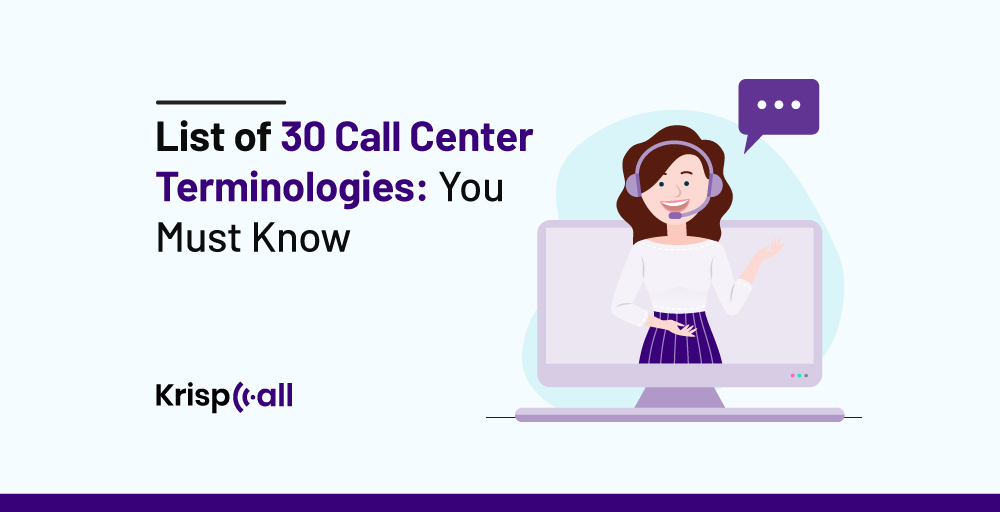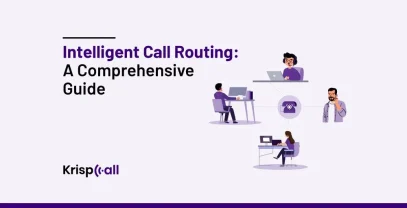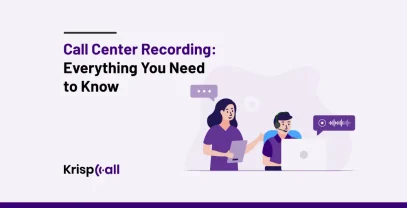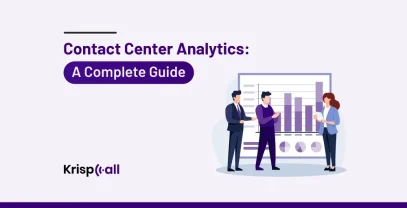Whether you’re a seasoned industry veteran or a newbie, you have to learn a variety of call center terminologies, no matter the cause of their usage. The verdict is in the pudding: the call center industry is growing explosively, and so is the quantity of the buzzwords used in it.
Well, the point is that these terms not only define the industry but also provide insights into the details of managing customer interactions efficiently. And if an agent fails to realize the importance of knowing each of those, that is the end for them.
So, here we are with a piled-up list of 30 must-know terminologies to help call center representatives step up their game or guide aspirants to build a career in the industry.
But, first things first!
What are Call Center Terminologies?
Call Center Terminologies are like any catchphrases, which are used as shorthand for simplifying complex technical definitions into a language that humans (specifically customers and agents) can understand.
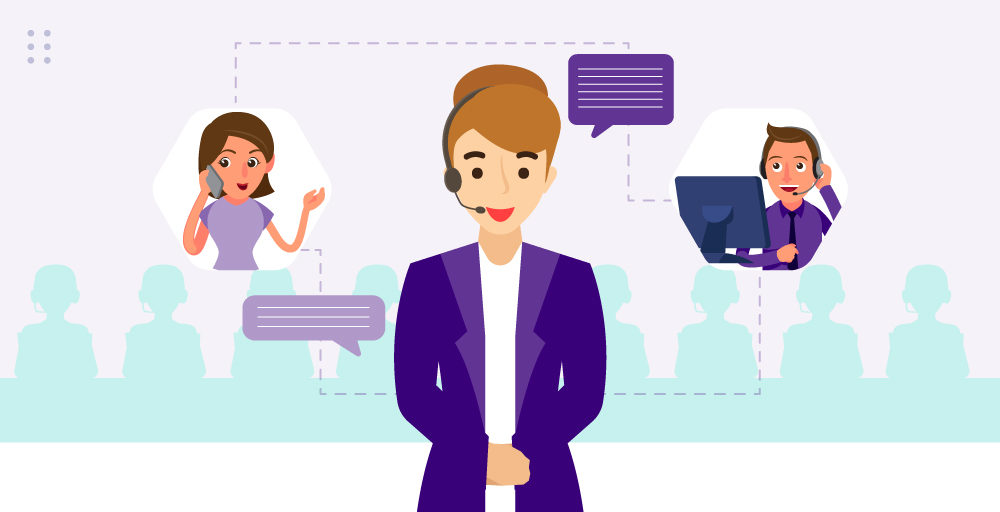
These words or phrases are typically used to describe specific processes, tools, or concepts and to make communication between agents and customers more effective and efficient.
Why is it important to learn about Call Center Terminologies?
Without a doubt, knowing call center technologies is just as important as learning the fundamentals of effective communication, especially for professionals who are directly or indirectly related to contact centers.
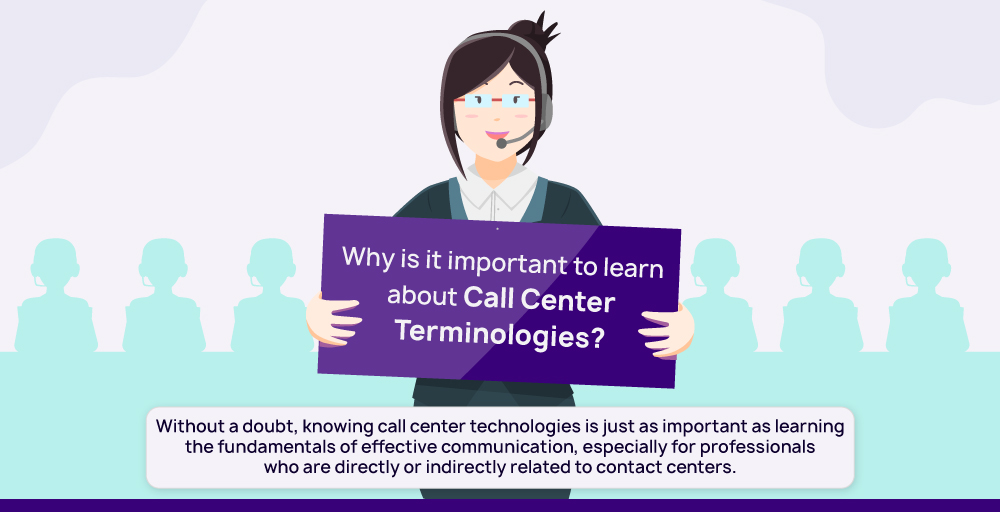
And guess what? Both elements are interrelated, and mastering both is essential for easy communication, problem-solving, enhancing performance, advancing careers, and, in the end, contributing to improved customer satisfaction.
Let’s get going with the Jargons!
30 of the Most Used Call Center Terminologies
1. ACD (Automatic Call Distribution)
Basically, it is a modern telephony solution that adapts to and follows the escalation hierarchy and preset guidelines of the business that uses it via machine learning techniques.
Automatic Call Distribution software’s purpose is to automatically manage and forward incoming calls, also known as inbound calls, to available representatives in order to reduce the turnaround time.
2. ANI (Automatic Number Identification)
You can think of it as a regular caller ID but better, and the technology behind its working is a bit different.
It is a telecommunications feature that shows the phone number of the caller to the recipient of a phone call, and caller ID blocking features do not affect the transmission of ANI information. It is mainly used by emergency call center dispatchers.
3. ASR (Automatic Speech Recognition)
ASR, an acronym for Automatic Speech Recognition, is a technology that allows individuals to use their voices to interact with a computer interface. It is also often interpreted as speech-to-text (STT).
It allows humans to speak with a computer interface in a way that resembles normal conversation, thus eliminating the need to input data using a keypad.
4. Average Handle Time (AHT)
This one is a popular one. Average Handle Time (AHT) is a metric used to measure how long it takes for an agent to complete an interaction, which includes conversation, wait time, and any follow-up activities and administration. It’s a standard measure used in the call center industry and is one of the most analyzed KPIs in the industry. It is calculated by the formula:
(Talk Time + Hold Time + After-work) / Total number of handled calls = AHT
5. Auxiliary Time (AUX)
Simple words- this means break time! When logged into an ACD system, call center agents make use of Auxiliary time (AUX) as a status that makes them unavailable for incoming calls.
It is primarily used to manage the workload of non-call activities and a variety of other significant reasons. Hence, it’s important to optimize staffing and keep service levels high.
6. Abandoned Call
Just like its name says, it is an inbound call that was initiated by a customer seeking assistance but was disconnected even before it reached a customer service representative. The reason for that may be an excessively long waiting time, technical issues, or delay due to operational inefficiency.
For call centers, this is a common issue that is tough to deal with and can have a significant negative influence on customer satisfaction and revenue.
7. Blended Agent
As an all-powerful hero, a Blended agent is a trained call center personnel who can or regularly handles customer interactions across multiple channels, such as phone(inbound and outbound calls), email, chat, and social media.
This approach is more and more being used by contact centers for its many benefits and to provide a seamless omnichannel experience to their customers.
8. Blended Universal Queue System (BUQS)
A Blended Universal Queue System (BUQS) is a customer service solution that integrates multiple channels of communication, like phone, email, chat, and social media, into a single queue(line).
It is done through the means of a cloud-based phone system that combines traffic from multiple channels, just like a unified callbox, allowing agents to handle customer interactions across various platforms without having to switch between systems.
9. Call Blending
It is a simple feature that allows the smooth delivery and making of all incoming and outgoing calls from customers and agents, respectively, using a single call center system.
It not only streamlines the operations but also optimizes agent productivity by monitoring incoming calls, agents’ availability, and other system metrics simultaneously and optimizing their skill and effectively the most of agent skills and time.
10. Call Center Schedule Adherence
Call Center Schedule Adherence or Adherence to Schedule can be referred to as the extent to which an agent has adhered on their own to a routine of work hours and breaks. It can also be interpreted as the time the agent was available for calls, the total time spent answering calls, the time spent on breaks, and the exact time spent waiting for calls.
It is a key common indicator that measures the efficiency of a call center’s staffing and scheduling practices and is calculated as such:
Scheduled Adherence = (Minutes in Adherence ➗ Total Scheduled minutes) ✖️ 100
11. Call Completion Rate (CCR)
It’s just a matter of math; call completion rate is the percentage or ratio of the number of calls that were successfully connected and completed to the total number of calls attempted. Some also regard it as the number of calls that are successfully served to completion per unit of time by a network.
It serves as a factual evaluation, meaning the higher its value, the higher the call center’s efficiency in connecting with customers and resolving their inquiries or issues. This is how it is calculated:
CCR = (Number of calls completed ➗ Total number of calls attempted) ✖️ 100
12. Call Detail Record (CDR)
A Call Detail Record (CDR) is a record file or a set of documentation that consists of all the minute details and information of telephone calls or other telephone transactions (messages).
Generally, CDRs are created and provided by telecommunication providers or VoIP service providers, and they contain precise information about the call, such as when, how, where, who, time, duration, completion status, source number, and destination number.
CDRs are typically used by businesses for reporting and billing purposes. They can also help businesses and concerned authorities monitor network activity and adjust services accordingly.
13. Call Routing
Often misunderstood as Automatic Call Distribution (ACD), call routing is a telephony management feature that is used by businesses, especially the ones with contact centers, to automatically place incoming or outgoing calls into a specific queue based on predefined criteria such as the volume of calls, the time of day, the caller’s language preference, or the department requested.
It works together with ACD to gather information on the calls for its intended purpose and helps businesses improve customer service, reduce call wait times, and increase efficiency.
14. Computer Telephony Integration (CTI)
Primarily used in call centers for the purpose of increasing the productivity of human agents, Computer Telephony Integration is a piece of tech that allows the integration of telephone systems into contact center representative’s computer applications.
With it, the user can make and receive calls, manage call details and logs, and access customer details all from their desktop or PC, eliminating the need for dedicated phone lines and manual management of the data.
15. Customer Experience Management (CEM or CXM)
To the basics, Customer Experience Management is the practice of providing top-notch services by using variable methods to clients as a way to boost loyalty and satisfaction. Technically, it is a strategic approach to planning, organizing, and executing customer-centric activities across the entire customer lifecycle.
CEM or CXM is a holistic model that keeps the customer at the center of every business operation and spans both physical interactions, such as a retail store experience, and digital interactions, such as websites and social media posts, whether it be pre-purchase or post-purchase.
16. Customer Relationship Management (CRM)
We all know this one- Customer Relationship Management is a strategic business method, mostly done through a combination of tactics, platforms, and technologies just to improve customer retention, increase sales & profitability, and boost customer satisfaction.
Its importance is clear, as it plays a vital role in the success stories of businesses in today’s competitive environment.
17. DNIS (Dialed Number Identification Service)
Used for a variety of purposes and being a common feature of Toll-free numbers, DNIS is a telecommunication feature made available by service providers upon request that enables businesses to identify the specific telephone number that a caller dialed to reach them.
18. First Call Resolution (FCR)
This one is a hot topic; First Call Resolution (FCR) or First Contact Resolution is one of the most essential and critical factors that defines the efficiency and effectiveness of call centers and customer service teams.
It is a figure that represents the percentage of queries handled and resolved by the agents at the very first call/contact without having to follow up or escalate those and is calculated as
FCR = (Cases resolved on first contact ➗ Total number of Cases) ✖️ 100
Note: The industry benchmark average for FCR is 70%. A first contact resolution rate of 80% or higher is considered “world-class.” – SQMgroup.
19. Hit Rate
Hit rate, often described as the success rate of an effort, can be viewed as a measurement of earnings management or business performance that is typically related to lead generation in sales. It is a ratio that is calculated by dividing marketing expenses by the number of people researching the product online, by phone, or in person. The formula for Hit Rate is-
Hit Rate = (Number of Sales ➗ Total number of Prospects) ✖️ 100
20. Interactive Voice Response (IVR)
For the modern call center industry, this one is a buzzword. Interactive Voice Response (IVR) is a unique piece of tech that allows telephone users to interact with a computer-operated telephone system through the use of voice and DTMF tones input with a keypad and access information without needing the help of an agent.
If you are a mobile phone or softphone user, you surely might have used an IVR system to get in touch with a business’s contact center, reach a banking informant, book a flight ticket, or be guided to a specific department of a hospital through their phone system.
21. Key Performance Indicator (KPI)
A Key Performance indicator (KPI) or performance indicator refers to a type of measurement unit or a set of quantifiable measurements that are used to gauge the long-term performance of a target, whether it be for tracking individual performance or the assessment of the success of an organization.
“KPIs are designed to track factors like efficiency, quality, timeliness, and performance.”
It is one of the most popular lingos used in the call center industry and specifically helps an organization identify areas of improvement and drive their decision-making forward toward their objectives and goals.
22. Live Monitoring
Live monitoring, also known as real-time monitoring, is an ever-going and continuous process of collection and analysis of data as it is generated to provide real-time insights into system performance, identify potential problems, and make informed decisions.
With it, operational officers can gain access to all the data being collected immediately without any delay, even if the process/interaction they want to monitor is ongoing.
Hence, it is a crucial and must-have component for businesses and organizations of all sizes in various industries that want to optimize operations, improve efficiency, and enhance customer satisfaction.
23. Predictive Dialer (PPD)
A Predictive Dialer can be understood as an upgraded version of an auto-dialer, but make no mistake, both have different sets of use cases.
A predictive dialer uses a combination of algorithms to predict when a real agent will be available to take a call and places multiple calls even before they are actually available in a very short interval. It keeps doing so again and again and, at the same time, drops the ones that are left unanswered.
This is done to minimize the downtime and idle time for agents and improve the overall productivity of the call center.
24. Quality Assurance (QA)
Having a crucial role to play in all call centers, Quality Assurance (QA) can be said to be a process that is used by organizations to ensure that products and services comply with standards and requirements.
With it, businesses can make sure that their contact center is operating in such a way that they are aligned with their real objectives while contributing to a positive customer experience.
25. Resolution Time
Resolution Time A.K.A Mean Time to Resolution (MTTR) or Time To Resolution (TTR) is a key metric used in the customer service industry to understand the average time it takes for a customer’s interaction from the initial point of contact with a company’s customer support team before their issue is resolved.
Contact centers use this formula to calculate average resolution time-
Resolution Time = Total Resolution Time ➗ Number of Tickets
26. Self-Service
A growing trend in the call center industry, Self-service is a process that allows customers and junior representatives alike to resolve commonly occurring issues without the need for additional support from agents and higher-ups, respectively.
Technologies like IVR, Chabots, Knowledge Bases, Online Portals, and FAQs are the primary methods that are used for self-service.
27. Service Level Agreement (SLA)
SLA, literally meaning Service Level Agreement, is a formal contract between a service provider and a customer that defines the level of service that the provider will deliver. It varies from customer to customer, as each of them may have opted for different levels of services.
SLAs are commonly used in call centers to set expectations for customer service metrics, such as average handle time (AHT), first call resolution (FCR), and abandonment rate, as well as to ensure excellence in service delivery.
28. Skill-Based Routing
You think of SBR as an improvement to most call centers’ automatic call distributor (ACD) systems. Just like ACDs, it’s used instead of simply selecting the next available and qualified agent based on skills and expertise and then routing the inbound call to them.
It is currently being wide in the cloud contact center landscape just to ensure that each customer is connected with the agent who is best equipped to handle their specific inquiry.
29. Talk Time
This one is a universally known one: Talk Time refers to the duration of a customer’s interaction with a call center agent and is typically measured in minutes and seconds or sometimes in hours.
30. Turnover
Don’t mistake this one with business turnover- that’s a completely different concept. In the call center sector, turnover is known as agent attrition, which means the rate at which agents leave a call center within a specific time period, calculated at said intervals.
It is said that higher employee turnover is directly related to increased operational costs, reduced productivity, and decreased customer satisfaction.
Wrapping up!
Now you have all the necessary knowledge at your fingertips, make sure that you, as a call center agent, are up-to-date and have gained mastery of these terms. With this solid understanding, you can build your professional image and easily navigate through the dynamic landscape of customer service.
Finally, to sum things up, in this blog, you learned what call center terminologies are, why it is important to learn, and discovered the most common ones used in the call center business.
FAQs
What is the Call Deflection Rate?
Call deflection rate is the percentage of customer support requests that are resolved without the need for a support agent (meaning the calls were “Deflected”) and is regarded as one of the key elements that contribute significantly to enhancing customer experience.
This includes requests that are handled by self-service tools such as FAQs, Tutorials, AI chatbots, Communities, and Portals. Sometimes, it can also refer to the rate at which a contact center’s non-call-based digital channels handle customer queries. It is calculated as such-
Call Deflection rate = (Self-support indices % ✖️ Entitled customer % ✖️ Self-support success rate % ✖️ Customer intent rate % ✖️ No further action rate %).
What is the Net promoter score (NPS)?
Net promoter score, or short NPS, is a measure of loyalty among consumers towards the company. It is the likelihood that a customer will recommend a company, product, or service to others and is determined by subtracting the percentage of negative reviews from the percentage of promoters.
NPS is calculated by asking customers one question: “On a scale from 0 to 10 (or 0 to 100), how likely are you to recommend this product/company to one of your friends or colleagues?”
What is First contact resolution (FCR)?
FCR, or First-Call Resolution, is a crucial customer service indicator that measures the percentage of customer inquiries or problems that are resolved during the first contact with a representative. It is an important metric for businesses because it provides a means of improving customer satisfaction, reducing costs, and increasing efficiency.

